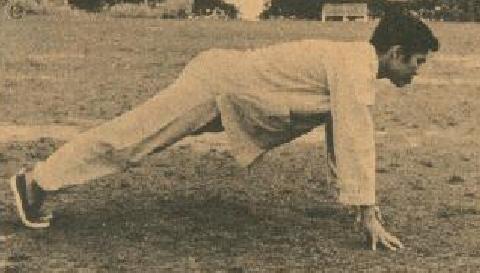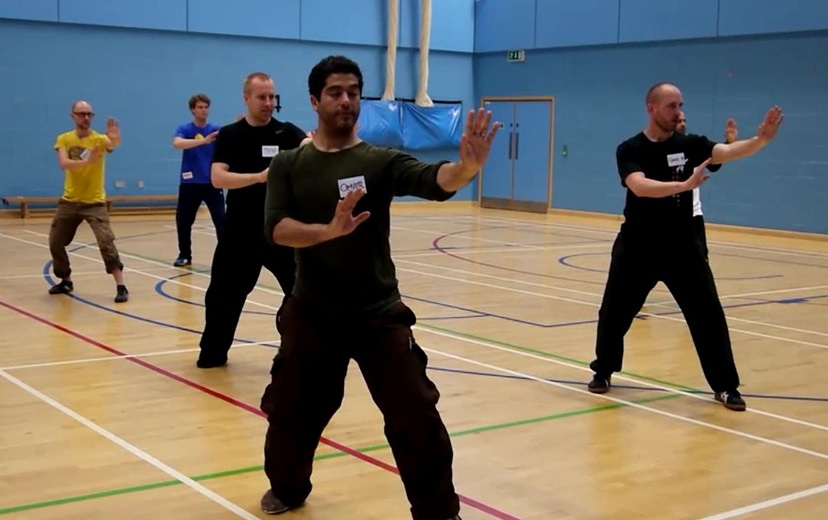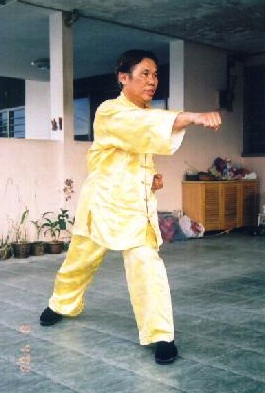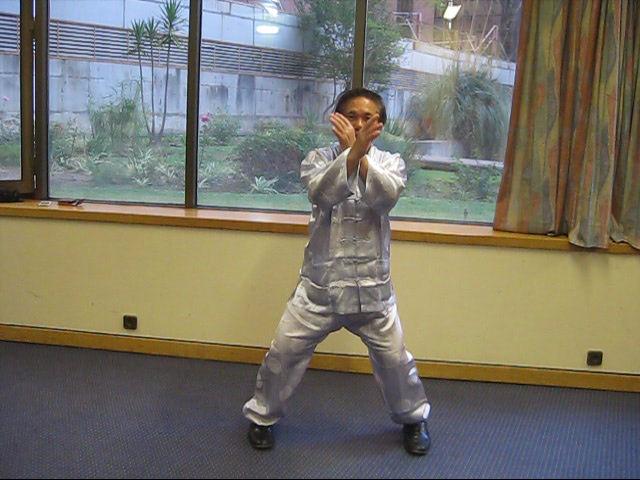SELECTION OF QUESTIONS AND ANSWERS
MARCH 2015 PART 2

Grandmaster Wong performing Taming Tiger, an external training method, during his younger days
Question 1
In Chinese kungfu as I have learned for some time, both directly and indirectly from many wonderfully enriching sources, I have come across somewhat arbitrary (although convenient) separations of concepts, such as the five elements or five techniques.
One very interesting one described a mixture of five techniques and 6 harmonies. The method of division basically gave 5 types of fundamental techniques for each of the six harmonies. It was fairly untraditional but its sources were very old.
For an example of the division, for external strength the muscles, bones, and skin were to be trained. And the five techniques for muscles were as follows; push, pull, lift, squat, and hip hinge. There were similar exercises for bones with the objective being hardness and skin exercises designed to create springy skin. The other three harmonies dealt with many of the same concepts Sifu Wong talks about.
— Charles, USA
Answer
I do not know what you mean by "five techniques", but the term "five elements" have been wrongly translated, though it has become established.
The Chinese term is "wu xing", which means "five movements" or "five processes". These "five processes" are represented as "metal", "wood", "water", "fire" and "water".
"Metal" does not represent the element or substance "metal", but the process symbolized by "metal", which is being resonant. "Wood" does not represent the element or substance "wood", but the process symbolized by "wood", which is growing. Similarly, "water" represents the process characterized by flowing, "fire" represents the process characterized by rising, and "earth" represents the process characterized by "coming together".
There are countless processes in the world, but they can be generalized into these five archetypal processes. The spread of knowledge, symbolized by "water", for example, has the tendency to overcome disagreement, symbolized by "fire". The interaction of these two processes -- spread of knowledge and disagreement -- is represented as water overcoming fire.
The examples of the five techniques given by you, namely pushing, pulling, lifting, squatting and hip hinging, are personal choices. In other words, a different person may choose other examples for these five techniques.
Question 2
I do not agree with much of the Eastern paradigms about Enlightenment as I am agnostic. I do not believe meditation will lead to a more powerful spirit or that I share a consciousness with anyone else.
Answer
Perhaps it is a matter of semantics, but Enlightenment or a glimpse of it known as a spiritual awakening, does not depend on a belief in God. In other words, whether you are agnostic or not, i.e. regardless of whether you believe God exists, you may have a glimpse of Cosmic Reality, or even merge into Cosmic Reality, if you want it and work hard enough to achieve it, provided you have met a competent teacher willing to teach you.
In scientific terms, without any religious connotations, Cosmic Reality is an undifferentiated spread of universal energy. However, due to our senses, we perceive Cosmic Reality as the phenomenal world differentiated into countless entities.
Regardless of your belief, meditation when practiced correctly will lead to a more powerful spirit, and you share a consciousness with all other people. As an analogy, regardless of whether you believe a knife can hurt you, if you cut yourself with the knife you will be hurt. Regardless of whether you believe you share a common law with other people, you have to be abided by this common law.
The collective consciousness that all humans share, irrespective of whether you believe in it or not, is called the alaya consciousness. When you look at a mass of energy that humans call a tree, albeit in different languages, you will see a tree. This is because you and all humans share the same alaya consciousness.
A bacterium or a fairy looking at the same mass of energy will see it differently. This is because they share different sets of collective consciousness.

Participants at a Xingyiquan course performing the Triangle Stance
Question 3
In a school so focused on tradition I wonder how the 3 external harmonies are getting sufficient training. Even in old Shaolin, there is evidence that weights or other heavy objects were used to train.
Answer
You are mistaken in your perception. In our school, Shaolin Wahnam, we cherish "internal and external double cultivation", or "noi nyoi sheong sau" in Chinese (Cantonese). "Noi nyoi sheong sau" was an ideal of all great kungfu masters.
We aim for six harmonies in all our training. For convenience, the six harmonies may be divided into three external harmonies and three internal harmonies.
The three external harmonies are the harmonies of legs, body and hands. The three internal harmonies are the harmonies of essence, energy and mind.
For example, when a practitioner performs a simple kungfu pattern like Black Tiger Steals Heart, he must attain the six harmonies. If his legs are not in line, his legs are not in harmony. If he arches his back, his body is not in harmony. If his fist is not in alignment with his arm, his hands are not in harmony. If his movement is staccato, his essence is not in harmony. If he tenses his muscles, his energy is not in harmony. If he is dull, his mind is not in harmony.
Question 4
There's no point in denying exercises like press ups and running, as Sifu Wong advised in some of his earlier books to use muscles in the basically Western sense. And also Shaolin monks of old trained bone density, muscular power, speed, and strength as well as their internal counterparts.
Answer
No one denies the benefits of press-ups and running. In my younger days, I spent a lot of time doing press-ups in an exercise called Taming Tiger, and running in the Art of Thousand Steps. I did press-ups over 100 times. In Taming-Tiger, an external exercise for Tiger-Claw, I used tiger-claws instead of open palms for press-ups.
Because of my training in the Art of Thousand Steps, I could run a few kilometres without panting and without feeling tired, and I could run up a building of 4 storeys in less than 8 seconds.
However, in my later years, I learned other training methods that were more cost-effective as well as less demanding, and I was quick to share them with my students. Instead of Taming Tiger, we now use One-Finger Shooting Zen, and instead of the Art of Thousand Steps, we now use running in chi flow.
Students at my Intensive Chi Kung Course, for example, including those who were elderly, could run round the training hall about 10 times, which was about the distance round a football field, without feeling tired and without panting. I couldn't do that when I was a schoolboy.
We use superior methods to improve our bone density, muscular power, speed and strength. Compared to others who use external methods for their training, our results are very good. Our female students, for example, could spar easily with Black Belts bigger in size and younger in age.
Editorial Note: Charless questions will be continued at March 2014 Part 3 issue of the Question-Answer Series.

Black Tiger Steals Hearet
Question 5
Where should I focus when practicing the Triangle Stance?
— Artur, Russia
Answer
You can gently focus at your dan tian or let your mind be empty. This is focusing on one or expanding to zero.
Question 6
When practicing the Horse-Riding Stance or the Three-Circle Stance, can I focus at the tang-chong or the bai-hui?
Answer
No, focusing on tang-chong (located at the sola plexus) may lock up energy at your heart, which is unpleasant and can be risky. Focusing on your bai-hui (located at the top of the head) makes you top-side heavy, and may make you feel dull or oppressed.
Gently focus at your dan tian (located at your abdomen), or keep you mind clear.

"Lifting Force" in the Iron Wire Set
Question 7
With Black Tiger, it feels like my hand moving from its chambered position at my side up into the striking path, enhanced by lifting force, the spiral force from my dan tian swirling through my body and releasing is enhanced by circulate force, my striking arm being carried forward by the spiral force manifesting soft force, then an added acceleration of straight force, followed by further acceleration and explosion from inch force, then chi in my fist consolidating on impact expressing hard force, all topped off by an unrelenting pressure of internal force towards my opponent manifesting pressing force.
All this occurs from False Leg Single Tiger to Bow Arrow Black Tiger in less than a second! I don't know how the other bridges will manifest yet but it is exciting so far! Very exciting!
— David, USA
Answer
This is an excellent description of your experience in executing Black Tiger. It also indicates your sound understanding of kungfu philosophy.
In Eastern wisdom, like in your description, philosophy follows experience. Experience came first. Those involved described their experiences. When a lot of people gave similar explanations to similar experiences, the explanations became established philosophy.
This is the reverse in modern Western culture. A thinker puts forth an idea. Then he goes into the real world to look for evidence to support his idea. Because he selects favorable evidence and ignores unfavorable ones, and if his results do not tally he can make some mathematical adjustment, he can almost always find evidence to support his idea, which then becomes philosophy.
Question 8
I was sparring a black belt friend of mine and I barely touched him in the stomach with this 7-bridge strike and he had to wait awhile before continuing, I showed him the remedial Lifting the Sky my Sifu taught me to help my sparring partners recover. So I was wondering if you could give me any insight into the way these 12 bridges seem to be working synergistically.
Answer
Of course, the 12 bridges work well, as proven by empirical evidence. However, today many people train the 12 bridges wrongly as isometric exercise. They still have a lot of force, but it is external force due to big muscles, and this external force will not have the same effect as your internal force on your sparring partner.
The 12 different types of force of the 12 bridges work synergistically by themselves. There is no need for us to do anything special, nor to philosophize on their synergy. The 12 different types of force are the same force operated differently. When we lift our arm, for example, it becomes lifting force. When we thrust our punch into an opponent in a relaxed, spiral manner, the same force becomes spiral, thrusting force. When we focus the force as we reach our target, the same force becomes inch force.
We just execute our punch, without worrying how our lifting force turns into spiral force and then inch force. We leave the argument to armchair philosophers who dull themselves in intellectualization but never experience the excitement of action.
It is very common that initially our students are not aware of the tremendous power of their internal force. So do be careful when you spar with friends. When you have progressed more deeply, you can cause damage even without contact. A few years ago during a sparring session on the Blue Mountain, your sisook, Piti from Colombia, broke a rib of his sparring partner even when he stopped his punch an inch or two from target!
Lifting the Sky followed by chi flow is an excellent way to overcome internal injury, but not a fracture. Piti's sparring partner, for example, had to be hospitalized to have his fractured rib repaired.
LINKS
Selected Reading
- Introduction to the 36 Strategies
- Intensive Courses and Special Courses
- What a Glorious Journey
- Combat Application of Tiger-Crane
- Circular Movement of Taijiquan
